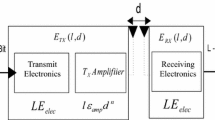Abstract
Wireless sensor networks consist of sensor nodes that are deployed in a large area and collect information from a sensor field. Since the nodes have very limited energy resources, the energy consuming operations such as data collection, transmission and reception must be kept to a minimum. Low Energy Adaptive Clustering Hierarchy (LEACH) is a cluster based communication protocol where cluster-heads (CH) are used to collect data from the cluster nodes and transmit it to the remote base station. In this paper we propose two extensions to LEACH. Firstly, nodes are evenly distributed during the cluster formation process, this is accomplished by merging multiple overlapping clusters. Secondly, instead of each CH directly transmitting data to remote base station, it will do so via a CH closer to the base station. This reduces transmission energy of cluster heads. The combination of above extensions increases the data gathering at base station to 60% for the same amount of sensor nodes energy used in LEACH.
Preview
Unable to display preview. Download preview PDF.
Similar content being viewed by others
References
Tilak, S., Abu-Ghazaleh, N., Heinzelman, W.: A taxonomy of wireless micor-sensor network models. ACM SIGMOBILE Mobile Computing and Communications Review 6, 28–36 (2002)
Park, S., et al.: Design of a wearable sensor badge for smart kindergarten. In: Proceedings of Sixth International Symposium on Wearable Computers (ISWC 2002), pp. 231–238 (2002)
Guru, S.M., et al.: Intelligent fastening with a-bolt technology and sensor networks. Assembly Automation, The International Journal of assembly technology and management 24, 386–393 (2004)
Heinzelman, W.R., Chandrakasan, A., Balakrishnan, H.: Energy-efficient communication protocol for wireless microsensor networks. In: Proceedings of the 33rd Annual Hawaii International Conference on System Sciences, pp. 3005–3014 (2000)
Lindsey, S., Raghavendra, C., Sivalingam, K.M.: Data gathering algorithms in sensor networks using energy metrics. IEEE Transactions on Parallel and Distributed Systems 13(9), 924–935 (2002)
Lindsey, S., Raghavendra, C.S.: Pegasis: Power-efficient gathering in sensor information systems. In: Aerospace Conference Proceedings, vol. 3, pp. 3–1125–3–1130 (2002)
Guru, S.M., et al.: An extended growing self-organising map for selection of clusters in sensor networks. International Journal of Distributed Sensor Networks 1(2), 227–243 (2005)
Hsu, A., Tang, S., Halgamuge, S.K.: An unsupervised hierarchical dynamic self-organising approach to class discovery and marker gene identification in microarray data. Bioinformatics 19, 2131–2140 (2003)
Muruganathan, S.D., et al.: A centralized energy-efficient routing protocol for wireless sensor networks. IEEE Communications Magazine 43(3), 8–13 (2005)
Heinzelman, W.: Application-Specific Protocol Architectures for Wireless Networks. PhD thesis, Massachusetts Institute of Technology (2000)
Handy, M.J., Haase, M., Timmermann, D.: Low energy adaptive clustering hierarchy with deterministic cluster-head selection. In: 4th International Workshop on Mobile and Wireless Communications Network, pp. 368–372 (2002)
Author information
Authors and Affiliations
Editor information
Rights and permissions
Copyright information
© 2007 Springer Berlin Heidelberg
About this paper
Cite this paper
Guru, S.M., Steinbrecher, M., Halgamuge, S., Kruse, R. (2007). Multiple Cluster Merging and Multihop Transmission in Wireless Sensor Networks. In: Cérin, C., Li, KC. (eds) Advances in Grid and Pervasive Computing. GPC 2007. Lecture Notes in Computer Science, vol 4459. Springer, Berlin, Heidelberg. https://doi.org/10.1007/978-3-540-72360-8_8
Download citation
DOI: https://doi.org/10.1007/978-3-540-72360-8_8
Publisher Name: Springer, Berlin, Heidelberg
Print ISBN: 978-3-540-72359-2
Online ISBN: 978-3-540-72360-8
eBook Packages: Computer ScienceComputer Science (R0)




